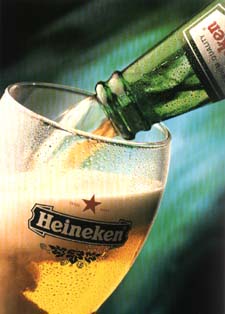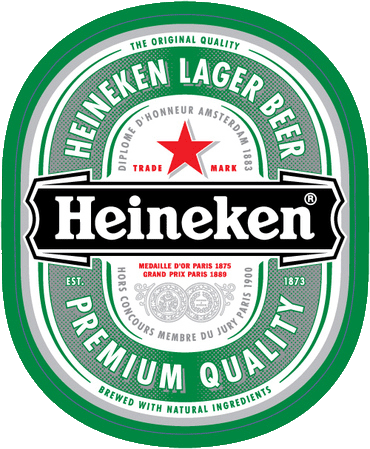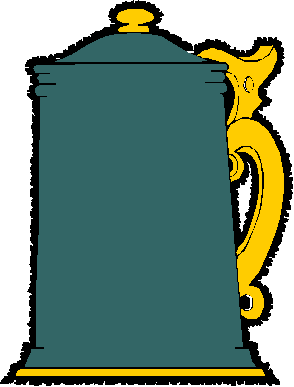Does this mean we’ll soon be seeing Guinness, Bass, and perhaps Heineken brewed in Pennsylvania anytime soon? Time will tell. Foster’s is already brewed in Canada for the US market, but I just can’t see imported beers brewed in this country. They wouldn’t be imports anymore.
Heineken has enough problems as it is in the United States. A few years ago, they lost the title of largest selling import to Corona, partially because of the rapid increase in the Hispanic population in the United States who brought with them a thirst for beer from their native land but also due to reasons outlined in Philip Van Munching's excellent book Beer Blast.
Beer Blast is an extremely well written account of the behind-the-scenes goings on in the modern American business of beer, and details information on major brewers like Pabst and Boston Beer and shows us how Philips father started the Van Munching Importing Company, sole importers of Heineken beer into the United States.
If you think Heineken Lager is the only beer the company makes, you’d be very wrong. They brew specialty beers that are mostly available in the home country of Holland. One of these is called Tarwebok, a delicious and rich dark malty wheat bock that I enjoyed when it was imported into the United States for a time. Heineken Dark is a beer I’ve tasted in the past but haven’t seen for a while. In addition, Heineken brews Amstel and Amstel Light which are widely available here in the states.
Recently, Heineken added the Murphy’s line of beers to their lineup when they acquired this Irish brewer famous for its stout. Though Murphy’s stout is still being brewed at the brewery in Ireland, the company is now known as Heineken Ireland. Bye-bye Murphy’s Brewery.
Heineken has a reputation in the United States for being skunked. Quite frequently, it is if you buy it in those horrible green bottles. If you’ve ever tasted draft Heineken you’ve no doubt noticed a big difference between it and its bottled brethren. The kicker is that the beer is sold in brown bottles back in the Netherlands. As the story goes, there was a shortage of brown glass in Europe after World War II, so the Dutch decided they’d send their beer to America in green glass since those silly Americans didn’t know anything about beer anyway. Green glass got associated with imported beer, and soon everybody was using it to give their beer that sophisticated look despite the fact it’s bad for the beer.
Heineken is a beer with history. The brewery was established in Amsterdam in 1592 as “the haystack” brewery. It did not obtain its present name until it was acquired by Gerard Adriaan Heineken in 1864, 100 years before the year I was born. Perhaps Gerard was getting ready for me. In any event, a new brewery was constructed in 1868 in Amsterdam, and a year later Heineken beer became the famous lager we know today. Previously, the brewery had produced ales.
The company enjoyed increases in sales both at home and abroad during the twenties. There was no prohibition in Holland, after all. The Dutch were a lot smarter than we silly Americans on that one. In 1929, Heineken began to bottle its beer. In the thirties, Heineken began expanding its export markets, and in 1939 Leo Van Munching began his fateful promotion of the brand in the United States.
 Today, Heineken is the world’s second-largest brewer after Anheuser Busch,
and is sold in more countries than any other beer in the world including
Budweiser. If you happen to visit Amsterdam, a trip to the brewery is
definitely in order. For Five Euros you can tour the Heineken Experience,
a mock-up brewery tour complete with brew kettles and bottling lines and of
course, Heineken beer. There’s even a ride that simulates how a bottle might
feel going down the bottling line.
Today, Heineken is the world’s second-largest brewer after Anheuser Busch,
and is sold in more countries than any other beer in the world including
Budweiser. If you happen to visit Amsterdam, a trip to the brewery is
definitely in order. For Five Euros you can tour the Heineken Experience,
a mock-up brewery tour complete with brew kettles and bottling lines and of
course, Heineken beer. There’s even a ride that simulates how a bottle might
feel going down the bottling line. I can't count the number of times I loaded cases of Heineken into a beer cooler, stocked the cold display, or rang it up at the register in my days as a beer retailer, but for some reason I just never drank it very often. I decided it might be a good idea to try the beer again tonight and take some tasting notes.
Heineken Lager is light golden in color, highly carbonated and produces a large foamy head with even a careful pour. The nose has traces of skunking present, a defect difficult to avoid with those nasty green bottles. The palate is, not surprisingly, rather smooth with a sweet maltiness and a touch of corn. The beer finishes with a respectable hop bite. A crisp, refreshing lager perfect for summer quenching.
Wherever I go and see Heineken signs I always get a kick out of those red stars against a green background. Perhaps a new slogan is in order. Heineken: official beer of the Chinese Communist Party.

Update September 1, 2012: Today, I still drink Heineken once and a awhile. When I do, though, it's not in a bottle or a can. Rather, I've become a fan of the Heineken Draft Keg to be used with the Krups Beertender Home Draft System. Essentially, you buy a 5 Liter mini-keg (I can get them right down the street at my Kroger supermarket for about $20), plop into the refrigerated Beertender chamber, connect the tap line and voila! Fresh tasty Heineken Lager.
This is a better way to enjoy Heineken, and you won't get the skunkiness you often do in the green bottles. The beer has a form, clean maltiness and a dry hop finish that is quite refreshing. With the Beertender, your brew will even stay fresh for up to 30 days. What will they think of next?
And remember, try a new beer today, and drink outside the box.
*Pricing data accurate at time of review or latest update. For reference only, based on actual price paid by reviewer.
(B)=Bottled
(D)=Draft
(G)=Growler

